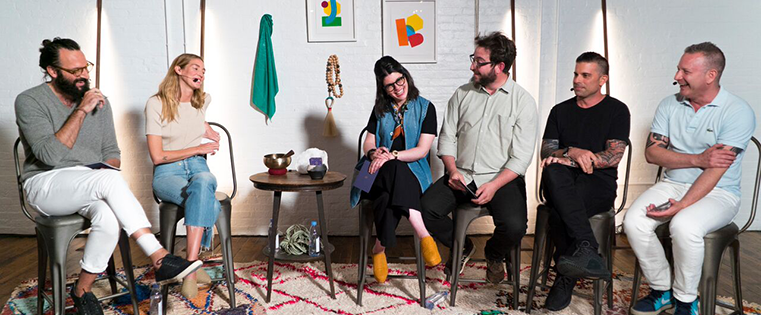
Not all creative insights are useful.
For instance, if you decided to design a four-story car with one wheel, no one would deny that the invention is creative, but it's not likely to be hailed as the next big thing in transportation.
Creativity needs to be informed by real perspectives and grounded in a real-world context. If you want to change the way people drive, you need to fully understand how they drive now, what they find challenging, and why they drive in the first place.
Ultimately, good design means creating something that people actually want to use. It's really quite simple in theory: If you consider the unique pain points and experiences of those around you, you're better able to devise creative, applicable solutions to their problems. The big challenge lies in stepping outside of your own calcified biases to adopt a more empathic perspective.
Applied Empathy
At Sub Rosa, a Manhattan-based strategy and design studio, enabling employees to escape their biases and develop a more empathic form of reasoning is vital to the agency's core philosophy and daily practice. Not only have they launched a successful podcaston the topic, they've also made empathy an integral part of their office's culture.
Michael Ventura, Sub Rosa's founder and CEO, recognized a deficit in the way empathy was discussed and practiced in agency culture.
"So many of the articles that we read and see out in the world are very theoretical when they talk about empathy," Ventura said. "It sounds very squishy. It sounds very loose, sometimes a little hippy-dippy. We really wanted to think about how empathy can be practically applied, and what is the process that would take."
Born from Ventura's desire to make empathy a tangible business practice and cultural cornerstone at Sub Rosa, applied empathy is essentially a method of detatching from your personal biases and tuning into the greater context of a situation.
"It's fun to have the 'wouldn't it be cool if,' type conversations," Ventura said, "[But] you can't blue sky something if you don't have a perspective. Empathy is a great way of allowing creative problems to be solved with a grounding in the reality that they need to be deployed within."
An Empathic Framework for Creative Projects
While it may seem easy to dismiss applied empathy as another marketing buzzword, Sub Rosa's commitment to empathy is backed up by an impressive portfolio. The agency has worked on high-profile projects for Pantone, Pepsi, and HP, among others.
Ventura credits their sustained success with a strategic framework developed to objectively employ empathic reasoning on their clients' projects. Centered around asking the right questions prior to writing the initial brief, the three-pronged process aims to help the agency develop a deep understanding of what a client wants to solve for or accomplish.
"The way we look at problem solving is really across these three buckets -- company, consumer, and context," Ventura said.
1) Consider the Company's Structure and Culture
To begin to understand where their client is coming from, Ventura and his team ask questions that reveal a client's cultural challenges and potential structural hurdles in their business model. Is their culture set up to support their objectives? What are their current strengths and weaknesses? Do they have the right team in place?
The goal here, Ventura explained, is "getting out of our own perceptions and getting into [the client's] vantage -- really understanding from the client side: what do they have that's going to help achieve this and where their deficiencies exist."
When examining a client's internal environment, Ventura stresses that it's also important to excavate their indigeny -- their history, underlying values, and central identity. Understanding what's indigenous to the client and their organization is crucial for crafting authentic work that accurately reflects the business. If the client's company isn't actually the most innovative product in the world, don't make a campaign that claims they are.
2) Consider the Consumer's Perspective
Next, Ventura's team turns their attention toward the client's target consumers, delving into their perspective to gain a deeper understanding of their interests, desires, and challenges.
What do the client's customers or consumers care about? What kind of content do they read? Where do they go out for fun?
"Whatever it might be," Ventura said, his team is focused on "getting ourselves empathically into the eyes and the minds and the hearts of the consumer, and looking outward from them to see the rest of the problem."
3) Consider the Greater Context
According to Ventura, it's not enough to simply make something that people want to buy. "You can have a business that has a good product and a customer who wants to buy it, but if they ignore the context, they're missing a very important third leg of the stool," he said.
To underscore the importance of grounding your work in a real-world context, Ventura likes to use the now-defunct SUV company Hummer as an example.
Back in 2008, Hummers were one of the most popular cars on the road. "There was a company who thought that big, aggressive, gas-guzzling vehicles were something to make and something someone would want," Ventura said. "Low and behold, they were right. There were a certain group of people who thought that car was great."
Despite their initially enthusiastic niche, Hummer's business plan had a major flaw: They ignored the rising eco-consciousness of the world and the impending gas and financial crises.
"Unfortunately, Hummer goes out of business," Ventura said. "Because while they had a willing audience to buy and a product that was interesting to that audience, they ignored the critical third leg of the stool, which is the context that they're operating within."
Recognizing Empathic Deficits
Cultivating an empathic practice isn't always natural or easy, but the first step is beginning to recognize specific empathic strengths and deficits in yourself.
To communicate these challenges more effectively and concretely, Sub Rosa's team has developed a series of empathic archetypes that characterize individual components of empathy.
"For some people, they're an optimistic problem solver," Ventura said. "For some people, they're better at looking for the chinks in the armor. There's a million scenarios in between. What we set out to do was understand a set of archetypes that one would need to embody in order to be comprehensively empathic."
What they ended up with was a set of seven empathic archetypes:
- Sage: Be present -- inhabit the here and now.
- Inquisitor: Question -- interrogate assumed truths.
- Convener: Host -- creatively anticipate the needs of others.
- Confidant: Listen -- summon the patience to observe and absorb information.
- Cultivator: Commit -- purposefully nurture and actively develop.
- Explorer: Dare -- be confident and unafraid to take risks or pivot.
- Alchemist: Experiment -- constantly test and try.
"The development of those archetypes was a way for us to almost create a scenario where we can play outside of our own biases or proclivities and actually work through problem solving with a different hat on," Ventura said. "That type of process has allowed our organization to really learn a lot about ourselves as individuals who work and solve problems because we can understand where we most often land in those archetypes."
As a starting point to figuring out which archetype you default to, ask yourself: Which of these archetypes am I more naturally inclined to? Which ones feel less natural?
Ventura explained there is immense value in knowing where you currently stand: "If someone was very inclined to be an explorer -- which is about being daring, being confident, unafraid to take risks -- and they are not very naturally inclined to be a sage -- which is about really listening before speaking, absorbing information -- one might actually force himself into the sage archetype more regularly so that they can have a bit more empathy for a problem from all sides."
Discussing empathy isn't always easy -- particularly with your colleagues -- but these archetypes provide a straightforward and common language for talking about the usually abstract topic.
"We all speak the same language," Ventura said. "Everyone at Sub Rosa knows these archetypes and has an understanding of how they play a role in problem solving. If I say to my colleagues, 'I'm never really good at the explorer in these types of situations. Can someone help me work through that?', we've now created a shorthand for the deficit. We now have this muscle memory and this shorthand that allows us to solve problems collaboratively by being self-aware."
Feature image courtesy of Sub Rosa.












